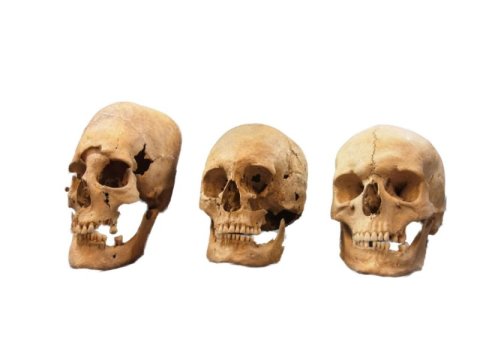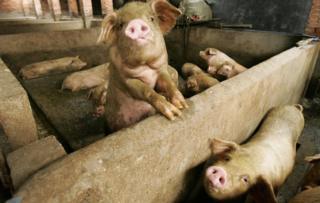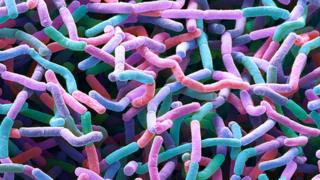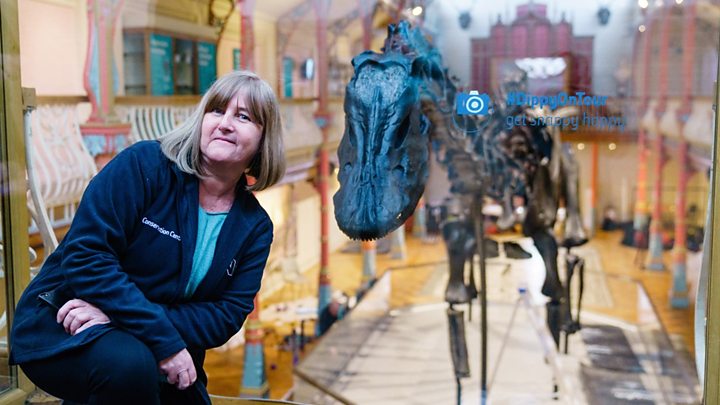These are strong, intermediate, and non-deformed skulls (from left to right) from the Early Medieval sites Altenerding and Straubing in Bavaria, Germany.
Credit: State Collection for Anthropology and Palaeoanatomy Munich.
New insights into the origin of elongated heads in early medieval Germany
Press Conference: Identification of main global environmental problems in Eastern Europe. The ecological aspect of use of nuclear technologies: pros and cons of using nuclear energy
We would like to invite you to our first official press conference in order to discuss important issues of environmental problems.
Genes remain active after death
Cells continue to function even after an individual dies. That’s according to a scientific study published in Nature Communications. Analysing post-mortem samples, an international team of scientists showed that some genes became more active after death. As well as providing an important dataset for other scientists, they also hope that this can be developed into a forensic tool.
Inside the cells of our bodies, life plays out under the powerful influence of our genes; their outputs controlled by a range of internal and external triggers. Understanding gene activity provides a perfect insight into what an individual cell, tissue or organ is doing, in health and in disease. Genes are locked away in the DNA present in our cells and when these are switched on, a tell-tale molecule called an RNA transcript is made.
Some of the RNA directly controls processes that go on in the cell, but most of the RNA becomes the blueprint for proteins. It’s the RNA transcripts that scientists often measure when they want to know what’s going on in our cells, and we call this analysis transcriptomics.
Inner workings
But obtaining samples for study isn’t an easy thing. Blood is relatively easy to get, but lopping off an arm or sticking a needle into a living person’s heart or liver is no trivial undertaking. So, scientists rely on a relatively abundant source of samples – tissues and organs removed after death.
Whilst studies of post-mortem samples can provide important insights into the body’s inner workings, it isn’t clear if these samples truly represent what goes on during life. The other confounding factor is that samples are rarely taken immediately after death, instead a body is stored until post-mortem examination and sampling can take place and its impact is unclear. And it’s this reliance on stored post-mortem samples that concerned Prof Roderic Guigó, a computational biologist based at the Barcelona Institute for Science and Technology and his team.
“You would expect that with the death of the individual, there would be a decay in the activity of the genes,” he explained. And this decay might affect proper interpretation of transcriptomics data.
Post-death throes
To see if this was the case the team used next generation mRNA sequencing on post-mortem specimens collected within 24 hours of death and on a subset of blood samples collected from some of the patients before death and, as Prof Guigó explained, what they discovered was surprising:
“There is a reaction by the cells to the death of the individual. We see some pathways, some genes, that are activated and this means that sometime after death there is still some activity at the level of transcription,” he said.
Although the exact reason the genes remained active was unclear, Prof Guigó does have one possible explanation: “I would guess that one of the major changes is due to the cessation of flow of blood, therefore I would say probably the main environmental change is hypoxia, the lack of oxygen, but I don’t have the proof for this.”
What the study did provide was a set of predictions of post-death RNA level changes for a variety of commonly studied tissues against which future transcriptomic analyses could be calibrated. And the understanding of the changes in RNA levels that occur after death might also be pivotal in future criminal investigations.
“We conclude there is a signature or a fingerprint in the pattern of gene expression after death that could eventually be used in forensic science, but we don’t pretend we have now a method that can be used in the field,” said Prof Guigó.
Whilst the data was consistent across different cadavers, and accurate predictions of time since death could be estimated from the RNA levels, Prof Guigó explained that extra work would be needed before its application in forensics could become a reality: “It requires further investigation, longer post-mortem intervals, not only 24 hours, the age of the individual, the cause of death – all of these will need to be taken into account if we are to convert this into a useful tool.”
Musk’s Tesla to stay in space for millions of years
The Tesla car that Elon Musk launched into space is likely to stay there for tens of millions of years before crashing into the Earth or Venus. That’s the conclusion of an analysis by Czech and Canadian researchers. They calculated that the roadster has a 6% chance of colliding with Earth and a 2.5% probability of hitting Venus over the next million years.
AI does grunt work on China’s pig farms
Artificial intelligence technology has been developed to help piglets survive their first months – and then to decide which sows to kill. The scheme is being rolled out in China, the world’s biggest producer and consumer of pork. It marks the latest deployment of tech giant Alibaba’s ET Brain cloud computing service. China’s pig industry is notoriously inefficient, but one expert said the tech could also prove useful elsewhere. For now, the trial is limited to the country’s Sichuan province.
New antibiotic family discovered in dirt
US scientists have discovered a new family of antibiotics in soil samples. The natural compounds could be used to combat hard-to-treat infections, the team at Rockefeller University hopes. Tests show the compounds, called malacidins, annihilate several bacterial diseases that have become resistant to most existing antibiotics, including the superbug MRSA.
New crayfish that doesn’t need males to mate becomes all-powerful
A mutant species of all-female crayfish taking over the world is not the latest science fiction film but a real-life environmental thriller. A new study has found that marbled crayfish are multiplying rapidly and invading ecosystems across the world. The ten-legged pests are descended from one single female with a mutation allowing it to reproduce without males.
These self-cloning ladies are found for sale in North America, despite a warning against keeping them as pets. Sales of the six-inch creature are already banned by the European Union. Procambarus virginalis did not exist three decades ago. Born to a male and female slough crayfish, a species originally from Florida, the original marbled crayfish had an additional set of chromosomes – a mutation that made her distinct from her parents and allowed her to reproduce without having to mate.
Now officially a separate species, the marbled crayfish can been found in the wild in Japan, Madagascar, multiple European countries and the US. The new study published in Nature, Ecology and Evolution describes the invasive species as a threat to wild ones, particularly seven native species in Madagascar.
“If you have one animal, essentially, three months later, you will have 200 or 300,” Dr Wolfgang Stein, one of the researchers, told Canadian public broadcaster CBC.
Dr Stein, who is a neurophysiologist at Illinois State University, told the BBC that they compared 11 marbled crayfish, spread through the pet trade to four locations on three continents. He noted that while they all share the DNA of one mother crayfish, there were some differences in “colouring”.
“The animal sequenced here by us in the US was more blue-ish than the ones from Germany and Madagascar,” Dr Stein said.
He believes this is where environmental influences may play a role in shaping the unique past of this freshwater crayfish’s life. “[Raised] in solitude they have a tendency to be blue”, and those socialised with others in their species tended to be more grey, he explained.
Curiously, scientists at the German Cancer Research Centre, that led the study, may be able to better understand how cancer tumours adapt and develop resistance to drug treatments, by studying the crayfish’s adaptability and ability to multiply. The crustaceans can be bought in pet shops in North America and through online adverts. One online seller from Ontario offered a one-inch self-cloning marbled crayfish for free and five larger ones for C$20 ($16; £11.50).
While there is not yet a wild population of marbled crayfish in Canada, the department of fisheries and oceans warned that it would be illegal to release any unwanted crayfish into the wild.
“Based on what is known about the reproductive behaviour of the marbled crayfish, we do not recommend Canadians keep these animals as pets,” Becky Cudmore, of the fisheries and oceans department, told CBC.
Mutant crayfish: What’s the background?
It all started in an aquarium in a German pet shop in the 1990s. A female slough crayfish was bornwith an additional set of chromosomes – a mutation that allowed her and her offspring to spawn hundreds of eggs at a time without a mate. The population of this genetically identical crayfish exploded within the pet trade, particularly among German aquarium hobbyists. But with the species able to reproduce exponentially within a few months, people began releasing unwanted crayfish – also known as marmorkrebs – into ponds and lakes across Europe, creating the thriving wild populations seen today.
The freshwater creatures’ ability to self-clone rapidly has led to them being compared with the fictional Tribble alien species from Star Trek, who are also able to multiply. Introduced as a cheap source of protein in Madagascar, the all-female species is now threatening native ones, creating an ecological nightmare for authorities. The European Union and two US states have already banned the marbled crayfish from being owned or traded, but populations in the wild continue to spawn.
Dippy: ‘The people’s dinosaur’ hits the road
Ask people to name museum exhibits in the UK and the chances are that a certain dinosaur will top their list. Dippy the Diplodocus has a special place in the hearts of so many, probably because it was the first thing they saw as a child when they entered London’s Natural History Museum. It’s one of those wow moments that stays with you all of your life. But you can’t have missed the news last year that this stop-you-in-your-tracks responsibility has since been passed to a blue whale skeleton.
Amazon fish challenges mutation idea
Evolutionary theory suggests that species favouring asexual reproduction will rapidly become extinct, as their genomes accumulate deadly mutations over time. But a study on an Amazon fish has cast doubt on the rapidity of this decline. Despite thousands of years of asexual reproduction, the genomes of the Amazon molly fish are remarkably stable and the species has survived.
Details of the work have been published in Nature Ecology and Evolution.
There are two fundamental ways in which new generations of life come to being – sexual and asexual reproduction. Sexual reproduction relies on special reproductive male and female sex cells, the eggs and sperm, joining together during the process of fertilisation. Each sex cell contains half the number of chromosomes of normal parent cells, then following fertilisation, when the egg and sperm fuse, the normal cell chromosome number is reinstated. Asexual reproduction is different.
A life born of celibacy
Instead of creating a new generation by mixing equal measures of DNA from the mother and father, asexual reproduction dispenses with the male and instead creates new offspring containing an exact copy of the mother’s genome – natural maternal cloning, if you like. This is an incredibly efficient way of creating new life. By not wasting genetic material on the creation of males, all offspring arising from asexual reproduction can go on to produce more. But there is a downside. Because the progeny are genetic facsimiles of the mother they exhibit limited variability.
And genetic variability can provide a big advantage. It’s what allows populations to respond and overcome changes in environment and other selective pressures – it underpins survival of the fittest. Sexual reproduction provides lots of scope to generate genetic variability; when pieces of individual chromosomes recombine as the eggs and sperm are formed and when the unique combinations of chromosomes are merged at fertilisation. Another advantage of sexual reproduction is that harmful mutations, which accumulate naturally over time, are diluted out and their effects nullified during this genetic mixing. Organisms relying on asexual transmission are presumed to forfeit these advantages.
Prof Manfred Schartl, who is based at the University of Würzburg and is one of the lead authors of the study, said: “The theoretical predictions were that an asexual species would undergo genomic decay and accumulate many bad mutations and, being clonal, would not be able to rely on high genetic diversity to react to new parasites or other changes in the environment.
“There were theoretical predictions that an asexual organism would demise after around 20,000 generations.”
In evolutionary biology circles, this gradual and fatal accumulation of deadly mutations is known as Muller’s ratchet, in honour of the Nobel prize-winning scientist Hermann Muller who came up with the theory. But the latest study of the long-term stability of the Amazon molly fish genome has thrown up some surprising new insights into the potential cost of asexual reproduction.
Beating the odds
The Amazon molly fish is thought to be a hybrid that arose following breeding between two related species of fish – the Atlantic molly and the Sailfin molly. In order to multiply, the resulting Amazon molly relies entirely on asexual reproduction; one of only a handful of backboned animals that reproduce this way. In an unusual twist, the Amazon molly female can only reproduce when exposed to the sperm of a related species of molly, but the sperm DNA doesn’t usually find its way into the offspring. To define the impact of its celibate lifestyle, the team compared the genome sequences of Amazon molly fish collected from various locations in Mexico and Texas.
Using the genome sequences the research team were able to build a phylogenetic, or family, tree. This tree showed that all the fish shared the same ancestor and this progenitor fish is predicted to have swum the American waters around 100,000 years ago.
Tenacious survivor
The Amazon molly had been around for half a million generations – far in excess of what theory would suggest. Not only that, but when the scientists looked for hallmarks of long-term genomic decay there were very few, as Prof Schartl explained:
“What we found is that this fish had preserved its hybrid genome and what we know from plant or animal breeding is that when we try to make something better we breed a hybrid”. And he thinks it’s this ‘hybrid vigour’ that underpins the Amazon molly’s tenacious survival.
“What nature has done is create from the beginning a good hybrid, which then thrived.”
“Of course it got mutations but what we feel has not been taken into consideration is that evolution will wipe out the deleterious mutations and only those that become better with good mutations will thrive.”
Commenting on the significance of the work, Dr Laurence Loewe, assistant professor at the Wisconsin Institute for Discovery at the University of Wisconsin-Madison told the BBC:
“Usually species without regular recombination are not very long-lived evolutionarily. However, the Amazon molly seems to have found a way of surviving for a surprisingly long time without accumulating signatures of genomic decay”.
“To figure out how, we will likely have to combine many of the exciting advances in evolutionary genetics from the last 100 years.”
Crypto-currency craze ‘hinders search for alien life’
Scientists listening out for broadcasts by extra-terrestrials are struggling to get the computer hardware they need, thanks to the crypto-currency mining craze, a radio-astronomer has said. Seti (Search for Extraterrestrial Intelligence) researchers want to expand operations at two observatories. However, they have found that key computer chips are in short supply.











